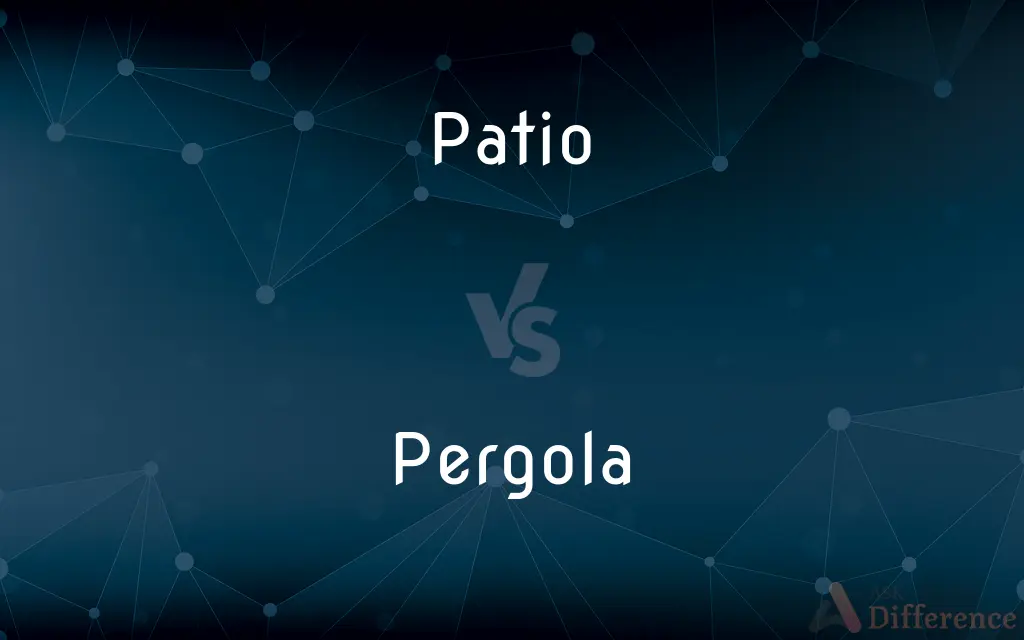Patio vs. Pergola — What's the Difference?
By Tayyaba Rehman & Fiza Rafique — Published on July 30, 2024
A Patio is an outdoor space for dining or recreation, typically paved. A Pergola is a structure with a roof of beams and rafters, used to provide partial shade.

Difference Between Patio and Pergola
Table of Contents
ADVERTISEMENT
Key Differences
Patios are ground-level outdoor areas directly adjacent to a house, made from various materials like concrete, pavers, stone, or brick. They serve as versatile spaces for dining, lounging, or entertaining. In contrast, Pergolas are garden features that consist of a framework covered with trailing plants or roofing materials, providing partial shade and serving as a decorative or functional space within a garden or over a patio.
While Patios can be standalone or attached to the house, providing a seamless transition from indoors to outdoors, Pergolas are primarily structures that may stand alone or connect to the house, enhancing the aesthetic appeal of an outdoor space. The purpose of a Pergola is to define a specific area, offer shade through its latticed roof, and support climbing plants, thereby integrating nature into the outdoor living experience.
The construction of a Patio focuses on the flooring, with designs that can include various patterns, colors, and textures to complement the home's exterior. Pergolas, however, emphasize vertical and overhead structures, with posts supporting beams and rafters that can be left open or covered for more shade. The choice of materials for both can vary, with wood, metal, and vinyl being popular for Pergolas, and stone, concrete, and brick commonly used for Patios.
Patios often require significant groundwork preparation, including excavation and laying a proper foundation to prevent shifting or cracking. Pergolas, while also needing a stable base, primarily involve above-ground construction, making their installation potentially less invasive to the existing landscape but still requiring careful planning for stability and durability.
Choosing between a Patio and a Pergola depends on the intended use, desired maintenance level, and aesthetic preference. A Patio offers a durable and versatile outdoor floor space, while a Pergola provides a charming framework for garden plants, a comfortable shaded area, and a dramatic visual element to the outdoor environment.
ADVERTISEMENT
Comparison Chart
Definition
Outdoor living space, typically paved, for recreation
Structure with a roof of beams/rafters for partial shade
Primary Function
Dining, lounging, entertaining area
Provides shade, supports climbing plants
Location
Adjacent to a house, can be standalone or attached
Can be over patios, gardens, or standalone
Construction Focus
Ground level with emphasis on flooring
Vertical structure with open lattice roof
Materials
Concrete, pavers, stone, brick
Wood, metal, vinyl, sometimes combined with plants
Installation
Requires groundwork and foundation
Above-ground, needs stable base but less invasive
Maintenance
Depends on material, generally low
Requires care for wood (if used) and climbing plants
Aesthetic Appeal
Enhances outdoor living space, variety of designs
Adds architectural interest, supports natural beauty
Compare with Definitions
Patio
Designed for outdoor leisure.
The patio provides a perfect spot for summer barbecues.
Pergola
Structured for partial shade.
The pergola's latticed roof filters sunlight, creating a comfortable shaded area.
Patio
Made from durable materials.
The stone patio blends beautifully with the garden.
Pergola
Enhances garden aesthetics.
The wooden pergola adds a charming focal point to the backyard.
Patio
Serves as an extension of living space.
The patio acts as a seamless transition from the indoors to the garden.
Pergola
Supports climbing plants.
Climbing roses add a fragrant, natural canopy to the pergola.
Patio
Offers flexibility in design.
The brick patterns on the patio add a unique touch to the outdoor space.
Pergola
Can be freestanding or attached.
The pergola extends from the house, providing a shaded walkway.
Patio
Requires groundwork preparation.
Installing the patio involved excavating and laying a solid foundation.
Pergola
Adds vertical interest.
The pergola's tall structure introduces an architectural element to the landscape.
Patio
An outdoor space for dining or recreation that adjoins a residence and is often paved.
Pergola
An arbor or a passageway of columns supporting a roof of trelliswork on which climbing plants are trained to grow.
Patio
A roofless inner courtyard, typically found in Spanish and Spanish-style dwellings.
Pergola
A framework in the form of a passageway of columns that supports a trelliswork roof; used to support and train climbing plants.
Patio
A paved outside area, adjoining a house, used for dining or recreation.
Pergola
Such a framework employed to provide shade, especially over a patio.
Patio
An inner courtyard typical of traditional houses in some regions of Spain.
The flat looks out on a patio on one side and a churro café on on the other.
Pergola
A framework that supports climbing plants;
The arbor provided a shady resting place in the park
Patio
A paved yard or floor where ores are cleaned and sorted, or where ore, salt, mercury, etc., are trampled by horses, to effect intermixture and amalgamation.
Patio
In Spain, Spanish America, etc., a court or courtyard of a house or other building; esp., an inner court open to the sky.
Patio
Usually paved outdoor area adjoining a residence
Common Curiosities
What is a Patio?
A patio is a paved outdoor area adjoining a house, used for dining, relaxation, or entertainment.
Can a pergola be built over a patio?
Yes, pergolas are often constructed over patios to provide shade and enhance the outdoor living space.
What maintenance does a pergola require?
Maintenance depends on the material, with wooden pergolas requiring periodic sealing or staining, and plants needing care.
What materials are used for patios?
Patios can be made from concrete, pavers, stone, brick, and other durable outdoor flooring materials.
How does a pergola provide shade?
Pergolas provide partial shade through their latticed roof, and additional shade can be achieved with climbing plants or fabric coverings.
Is a permit required to build a patio or pergola?
Permit requirements vary by location and project scope; it's advisable to check local regulations before construction.
How does a patio enhance outdoor living?
A patio expands living space to the outdoors, offering a durable and versatile area for a variety of activities.
What is a Pergola?
A pergola is an outdoor garden feature forming a shaded walkway, passageway, or sitting area with vertical posts and an open lattice.
Can pergolas withstand harsh weather?
Pergolas designed with durable materials and proper installation can withstand various weather conditions, but extreme weather may require additional protection.
How do I choose between a patio and a pergola?
Consider your outdoor needs, space, budget, and desired aesthetic. Patios offer versatile ground space, while pergolas provide vertical interest and shaded areas.
Share Your Discovery

Previous Comparison
New York vs. New Jersey
Next Comparison
Accelerators vs. IncubatorsAuthor Spotlight
Written by
Tayyaba RehmanTayyaba Rehman is a distinguished writer, currently serving as a primary contributor to askdifference.com. As a researcher in semantics and etymology, Tayyaba's passion for the complexity of languages and their distinctions has found a perfect home on the platform. Tayyaba delves into the intricacies of language, distinguishing between commonly confused words and phrases, thereby providing clarity for readers worldwide.
Co-written by
Fiza RafiqueFiza Rafique is a skilled content writer at AskDifference.com, where she meticulously refines and enhances written pieces. Drawing from her vast editorial expertise, Fiza ensures clarity, accuracy, and precision in every article. Passionate about language, she continually seeks to elevate the quality of content for readers worldwide.













































